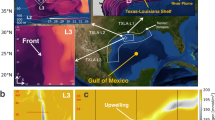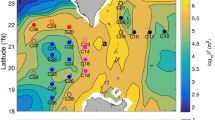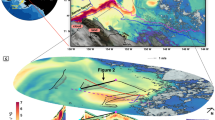Abstract
Buoyancy exchange between the deep and the upper ocean, which is essential for maintaining global ocean circulation, mainly occurs through turbulent mixing1,2. This mixing is thought to result primarily from instability of the oceanic internal wave field3, but internal waves tend to radiate energy away from the regions in which they are generated rather than dissipate it locally as turbulence4 and the resulting distribution of turbulent mixing remains unknown. Another, more direct, mixing mechanism involves the generation of turbulence as strong flows pass through narrow passages in topography, but the amount of turbulence generated at such locations remains poorly quantified owing to a lack of direct measurements. Here we present observations from the crest of the Mid-Atlantic Ridge in the subtropical North Atlantic Ocean that suggest that passages in rift valleys and ridge-flank canyons provide the most energetic sites for oceanic turbulence. Our measurements show that diffusivities as large as 0.03 m2 s-1 characterize the mixing downstream of a sill in a well-stratified boundary layer, with mixing levels remaining of the order of 10-4 m2 s-1 at the base of the main thermocline. These mixing rates are significantly higher than the diffusivities of the order of 10-5 m2 s-1 that characterize much of the global thermocline and the abyssal ocean5. Our estimates suggest that overflows associated with narrow passages on the Mid-Atlantic Ridge in the North Atlantic Ocean produce as much buoyancy flux as has previously been estimated for the entire Romanche fracture zone6,7, a large strait in the Mid-Atlantic Ridge that connects the North and South Atlantic basins. This flux is equivalent to the interior mixing that occurs in the entire North Atlantic basin at the depth of the passages, suggesting that turbulence generated in narrow passages on mid-ocean ridges may be important for buoyancy flux at the global scale.
This is a preview of subscription content, access via your institution
Access options
Subscribe to this journal
Receive 51 print issues and online access
$199.00 per year
only $3.90 per issue
Buy this article
- Purchase on Springer Link
- Instant access to full article PDF
Prices may be subject to local taxes which are calculated during checkout




Similar content being viewed by others
References
Munk, W. H. Abyssal recipes. Deep-Sea Res. 13, 207–230 (1966)
Munk, W. & Wunsch, C. Abyssal recipes. II: Energetics of tidal and wind mixing. Deep-Sea Res. 45, 1977–2010 (1998)
Munk, W. in Evolution of Physical Oceanography 264–291 (The MIT Press, Cambridge, 1981)
St Laurent, L. C. & Garrett, C. The role of internal tides in mixing the deep ocean. J. Phys. Oceanogr. 32, 2882–2899 (2002)
Kunze, E. & Sanford, T. B. Abyssal mixing: where it is not. J. Phys. Oceanogr. 26, 2286–2296 (1996)
Polzin, K. L., Speer, K. G., Toole, J. M. & Schmitt, R. W. Intense mixing of Antarctic Bottom Water in the equatorial Atlantic Ocean. Nature 380, 54–57 (1996)
Bryden, H. L. & Nurser, A. J. G. Effects of strait mixing on ocean stratification. J. Phys. Oceanogr. 33, 1870–1872 (2003)
Girton, J. B. & Sanford, T. B. Descent and modification of the overflow plume in the Denmark Strait. J. Phys. Oceanogr. 33, 1351–1364 (2003)
Farmer, D. & Armi, L. The flow of Mediterranean water through the Strait of Gibraltar. Prog. Oceanogr. 21, 1–105 (1988)
Hogg, N. G., Biscaye, P., Gardner, E. & Schmitz, W. J. On the transport of Antarctic Bottom Water in the Vema Channel. J. Mar. Res. 40 (Suppl.). 231–263 (1982)
Thurnherr, A. M. Diapycnal mixing associated with an overflow in a deep submarine canyon. Deep-Sea Res. II 53, 194–206 (2006)
Thurnherr, A. M. & Richards, K. R. Hydrography and high-temperature heat flux of the rainbow hydrothermal site (36:14N, Mid-Atlantic Ridge). J. Geophys. Res. 106, 9411–9426 (2001)
Thurnherr, A. M., Richards, K. J., German, C. R., Lane-Serff, G. F. & Speer, K. G. Flow and mixing in the rift valley of the Mid-Atlantic Ridge. J. Phys. Oceanogr. 32, 1763–1778 (2002)
Thurnherr, A. M., St Laurent, L. C., Speer, K. G., Toole, J. M. & Ledwell, J. R. Mixing associated with sills in a canyon on the mid-ocean ridge flank. J. Phys. Oceanogr. 35, 1370–1381 (2005)
Escartin, J. Monitoring the Mid-Atlantic Ridge (MoMAR) 〈http://www.ipgp.jussieu.fr/rech/lgm/MOMAR/〉 (2006)
Osborn, T. R. Estimates of the local rate of vertical diffusion from dissipation measurements. J. Phys. Oceanogr. 10, 83–89 (1980)
Webb, D. J. & Suginohara, N. Vertical mixing in the ocean. Nature 409, 37 (2001)
St Laurent, L. & Simmons, H. L. Estimates of power consumed by mixing in the ocean interior. J. Clim. 19, 4877–4890 (2006)
Keller, G. H., Anderson, S. H. & Lavelle, J. W. Near-bottom currents in the Mid-Atlantic Ridge rift valley. Can. J. Earth Sci. 12, 703–710 (1975)
Wilson, C., Speer, K., Charlou, J.-L., Bougault, H. & Klinkhammer, G. Hydrography above the Mid-Atlantic Ridge (33°-40°N) and within the Lucky Strike segment. J. Geophys. Res. 100, 20555–20564 (1995)
Smith, D. K. & Sandwell, D. Global sea floor topography from satellite altimetry and ship depth soundings. Science 277, 1956–1962 (1997)
Joyce, C. & Corry, C. WHP 90–1: Requirements for WOCE Hydrographic Program Data Reporting 〈http://cchdo.ucsd.edu/manuals.htm〉 (1994)
Visbeck, M. Deep velocity profiling using lowered acoustic Doppler current profiler: bottom track and inverse solutions. J. Atmos. Ocean. Technol. 19, 794–807 (2002)
Rockland Scientific International. Microstructure Instruments—VMP 5500 〈http://www.rocklandscientific.com/products_vmp5500.php〉 (2006)
Lueck, R. G., Wolk, F. & Yamazaki, H. Oceanic velocity microstructure measurements in the 20th century. J. Oceanogr. 58, 153–174 (2002)
Gregg, M. C. Uncertainties and limitations in measuring ε and χ. J. Atmos. Ocean. Technol. 16, 1483–1490 (1999)
Emery, W. J. & Thomson, R. E. Data Analysis Methods in Physical Oceanography (Elsevier Science, Amsterdam, 2001)
Cannat, M. et al. Mid-Atlantic Ridge-Azores hotspot interactions: Along-axis migration of a hotspot-derived event of enhanced magmatism 10 to 4 Ma ago. Earth Planet. Sci. Lett. 173, 257–269 (1999)
Acknowledgements
We thank V. Ballu for inviting us to join the GRAVILUCK cruise. We also thank P. Bouruet-Aubertot, G. Reverdin, and the scientific staff and crew of the N/O Atalante for their assistance during the field programme. Technical support of the DMP by R. Lueck, F. Wolk, and P. Stern of Rockland Scientific, and by E. Howarth of FSU, was invaluable. E. Kunze provided comments on the early draft of the manuscript. The FSU turbulence instrumentation programme is supported by the US Office of Naval Research. The LDEO lowered ADCP programme, and our participation in GRAVILUCK, was sponsored by the US National Science Foundation.
Author Contributions L.C.StL. and A.M.T. contributed equally to this work. L.C.StL. led the microstructure sampling programme, and analysed the turbulence data. A.M.T. led the lowered ADCP measurement programme, and analysed the velocity data.
Author information
Authors and Affiliations
Corresponding author
Ethics declarations
Competing interests
Reprints and permissions information is available at www.nature.com/reprints. The authors declare no competing financial interests.
Rights and permissions
About this article
Cite this article
St Laurent, L., Thurnherr, A. Intense mixing of lower thermocline water on the crest of the Mid-Atlantic Ridge. Nature 448, 680–683 (2007). https://doi.org/10.1038/nature06043
Received:
Accepted:
Issue Date:
DOI: https://doi.org/10.1038/nature06043
This article is cited by
-
Iron Biogeochemistry in the High Latitude North Atlantic Ocean
Scientific Reports (2018)
-
Contrasted turbulence intensities in the Indonesian Throughflow: a challenge for parameterizing energy dissipation rate
Ocean Dynamics (2018)
-
Impact of remotely generated eddies on plume dispersion at abyssal mining sites in the Pacific
Scientific Reports (2017)
-
Strong transport and mixing of deep water through the Southwest Indian Ridge
Nature Geoscience (2008)
Comments
By submitting a comment you agree to abide by our Terms and Community Guidelines. If you find something abusive or that does not comply with our terms or guidelines please flag it as inappropriate.



